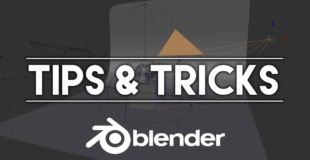https://i.ytimg.com/vi/pZxJo9IPVCM/hqdefault.jpg
Subscribe: https://www.youtube.com/subscription_…
Custom Graphics: http://remingtongraphics.net/
More information below! Please leave a like if you enjoyed!
In this video, you will learn:
1) Lock camera to view
2) Following curves
3) Using empties
4) Switching between cameras
5) Camera settings
Want more Blender tips and tricks? Click subscribe!
source

42 responses to “5 Blender Camera Tricks [Cinematography & Animation]”
this guy talked so much over this music and explained everything without telling us how to animate the actual dumb focal length.
Such a horrible video
You deaf or something?
So useful! Great overview, thanks!
Is this blender
Finally I found this 🙌. Camera movement is for beginners 🤪. Please update this for 2.80, so many things changed…
My camera has got a too little range you understand? That means I can't see very far. Could you help me please?
please take off this fucking background music
Hi thanks for the video > For the shift translate feature in the camera, is it possible somehow to export the shift animation keys to After Effects? Using the in-built Blender to AE plugin, I get just the loc/rot and lens info into AE but unable to get the shift information and really need this as it's animated and using it with some simple 2D backgrounds in After Effects
Thanks mate
This was very helpful, thanks. I think you were able to answer my questions about objects not rendering. It was the clipping settings I think. This gives me something else to try.
la la la lalala lol😂
thanks a lot
turn off your music/…eakk
Stupid background music.
Thank you for making this tutorial. I am really new to blender so every bit helps 🙂
mc Eiht
La-lalallallaa-la!
Great Tutorial Did not know about the multiple camera trick or the focus settings. Great job thanks
I love you
Audio crackles and AWFUL music…. WHY ????
music is too loud. Can't hear your voice well man.
Thanks for tutorial.
The music is REALLY loud for background music.
I hope they improve the camera in 2.8 even in the camera you need to be more technical and the Numpad 0 is really not good like back and forth etc. setting the camera manually without looking in the camera is not so good. unlike in 3ds max you can set automatically the target camera or link that to the object. or maybe I'm just new to this good camera?
How do I delay when a camera starts to follow a path?
좋은 강좌 잘 봤습니다. ^ ^
Some good tips, but you could have almost cut it in half if you didn't repeat yourself so much.
ctrl+t to follow suzane
thank you this helped me a lot
Can't hear you over the music. Fail
Nice video, thanks. BUT A PROBLEM SHOWED UP! I pressed 0 to go to camera view and the program got me stuck into that view, I dropped out and now I cannot see through the cameras, but whenever I press 0, it drives me to the view it leaded me at the very beginning, any idea of why this crazy software did that and how to fix it? I already tried to restart the program, it does not work!
Music is so distracting
Could you demonstrate how to use a mist effect to obscure the Level of Detail at extreme camera range?
Panoramic mode for the camera enables you to create your own custom HDRI images for backgrounds. You'd setup a scene with background details, mountains, hills, trees, beaches, sun, moon, etc. then you'd set your camera to Panoramic mode, kick up your resolution as high as you need it, (only works in Cycles Render mode despite the option being there in Blender Render) then switch the lens type to Equirectangular, and Blender will render your scene creating a 360 degree image you can use as an HDRI background image. To get the environment lighting to work correctly in your custom 360 degree background image you need to save the image in the HDR format, which saves the light intensity data.
I'm not sure why your tutorials don't cover some pretty basic things that I learned back in Blender 2.45 that still work in the current versions of Blender. When parenting an object to follow a path, instead of moving the object by hand to the start of the path to eliminate the hierarchy line (line showing the parent/child relationship), all you have to do, incase you didn't know is select the object you want to follow the path then press [Alt] + [O] to clear the objects origin and it will automatically jump to the beginning of the path, then in the Object tab of the Properties Panel, you can chose which local axis of the object will be looking along the path and which local axis will be facing up.
haha Adios! Gracias great video!
Tip #4 !!!! awesome!! I use to render still images from various angles with different cameras, using this tip I could make a short animation with one view per frame and render all the views at once! thank you!
5:57 You can press R twice to rotate the camera in camera view
12:16 someone get in the house?
great video dude! could you tell me what beat you used (with the "la la la" sample)? I've heard it someplace
Super cool tutorial! Fresh joyfull voice!
thank you for a really helpful video